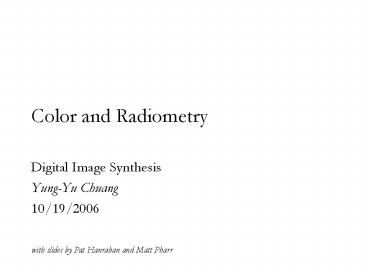Color and Radiometry - PowerPoint PPT Presentation
Title:
Color and Radiometry
Description:
Digital Image Synthesis. Yung-Yu Chuang. 10/19/2006. with s by ... These radiometric quantities are described by their spectral power distribution (SPD) ... – PowerPoint PPT presentation
Number of Views:25
Avg rating:3.0/5.0
Title: Color and Radiometry
1
Color and Radiometry
- Digital Image Synthesis
- Yung-Yu Chuang
- 10/19/2006
with slides by Pat Hanrahan and Matt Pharr
2
Radiometry
- Radiometry study of the propagation of
electromagnetic radiation in an environment - Four key quantities flux, intensity, irradiance
and radiance - These radiometric quantities are described by
their spectral power distribution (SPD) - Human visible light ranges from 370nm to 730nm
3
Spectral power distribution
400nm (bluish)
650nm (red)
550nm (green)
fluorescent light (???)
4
Spectral power distribution
lemmon skin
5
Color
- Need a compact, efficient and accurate way to
represent functions like these - Find proper basis functions to map the
infinite-dimensional space of all possible SPD
functions to a low-dimensional space of
coefficients - For example, B(?)1, a bad approximation
6
Spectrum
- In core/color.
- Not a plug-in, to use inline for performance
- Spectrum stores a fixed number of samples at a
fixed set of wavelengths. Better for smooth
functions. - define COLOR_SAMPLE 3
- class COREDLL Spectrum
- public
- ltarithmetic operationsgt
- private
- float cCOLOR_SAMPLES
- ...
Why is this possible? Human vision system
We actually sample RGB
component-wise - / comparison
7
Human visual system
- Tristimulus theory all visible SPDs can be
accurately represented for human observers with
three values, x?, y? and z?. - The basis are the spectral matching curves, X(?),
Y(?) and Z(?).
8
XYZ basis
pbrt has discrete versions (sampled every 1nm) of
these bases in core/color.cpp
360
830
9
XYZ color
- Its, however, not good for spectral computation.
A product of two SPDs XYZ values is likely
different from the XYZ values of the SPD which is
the product of the two original SPDs. - Hence, we often have to convert our samples (RGB)
into XYZ - void XYZ(float xyz3) const
- xyz0 xyz1 xyz2 0.
- for (int i 0 i lt COLOR_SAMPLES i)
- xyz0 XWeighti ci
- xyz1 YWeighti ci
- xyz2 ZWeighti ci
10
Conversion between XYZ and RGB
- float SpectrumXWeightCOLOR_SAMPLES
- 0.412453f, 0.357580f, 0.180423f
- float SpectrumYWeightCOLOR_SAMPLES
- 0.212671f, 0.715160f, 0.072169f
- float SpectrumZWeightCOLOR_SAMPLES
- 0.019334f, 0.119193f, 0.950227f
- Spectrum FromXYZ(float x, float y, float z)
- float c3
- c0 3.240479f x -1.537150f y
-0.498535f z - c1 -0.969256f x 1.875991f y
0.041556f z - c2 0.055648f x -0.204043f y
1.057311f z - return Spectrum(c)
11
Basic radiometry
- pbrt is based on radiative transfer study of the
transfer of radiant energy based on radiometric
principles and operates at the geometric optics
level (light interacts with objects much larger
than the lights wavelength) - It is based on the particle model. Hence,
diffraction and interference cant be easily
accounted for.
12
Basic assumptions about light behavior
- Linearity the combined effect of two inputs is
equal to the sum of effects - Energy conservation scattering event cant
produce more energy than they started with - No polarization that is, we only care the
frequency of light but not other properties - No fluorescence or phosphorescence behavior of
light at a wavelength doesnt affect the behavior
of light at other wavelengths - Steady state light is assumed to have reached
equilibrium, so its radiance distribution isnt
changing over time.
13
Fluorescent materials
14
Flux (F)
- Radiant flux, power
- Total amount of energy passing through a surface
per unit of time (J/s,W)
15
Irradiance (E)
- Area density of flux (W/m2)
Lamberts law
Inverse square law
16
Angles and Solid Angles
- Angle
- Solid angle
- The solid angle subtended by a surface is
defined as the surface area of a unit sphere
covered by the surface's projection onto the
sphere.
Þ circle has 2p radians
Þ sphere has 4p steradians
17
Intensity (I)
- Flux density per solid angle
- Intensity describes the directional distribution
of light
18
Radiance (L)
- Flux density per unit area per solid angle
- Most frequently used,
- remains constant along ray.
- All other quantities can
- be derived from radiance
19
Calculate irradiance from radiance
20
Irradiance Environment Maps
Radiance Environment Map
Irradiance Environment Map
21
Differential solid angles
Goal find out the relationship between d? and
d?, d?
22
Differential solid angles
Goal find out the relationship between d? and
d?, d?
23
Differential solid angles
We can prove that
24
Differential solid angles
We can prove that
25
Isotropic point source
If the total flux of the light source is F, what
is the intensity?
26
Isotropic point source
If the total flux of the light source is F, what
is the intensity?
27
Warns spotlight
If the total flux is F, what is the intensity?
28
Warns spotlight
If the total flux is F, what is the intensity?
29
Irradiance isotropic point source
What is the irradiance for this point?
30
Irradiance isotropic point source
31
Irradiance isotropic point source
32
Photometry
Luminance































